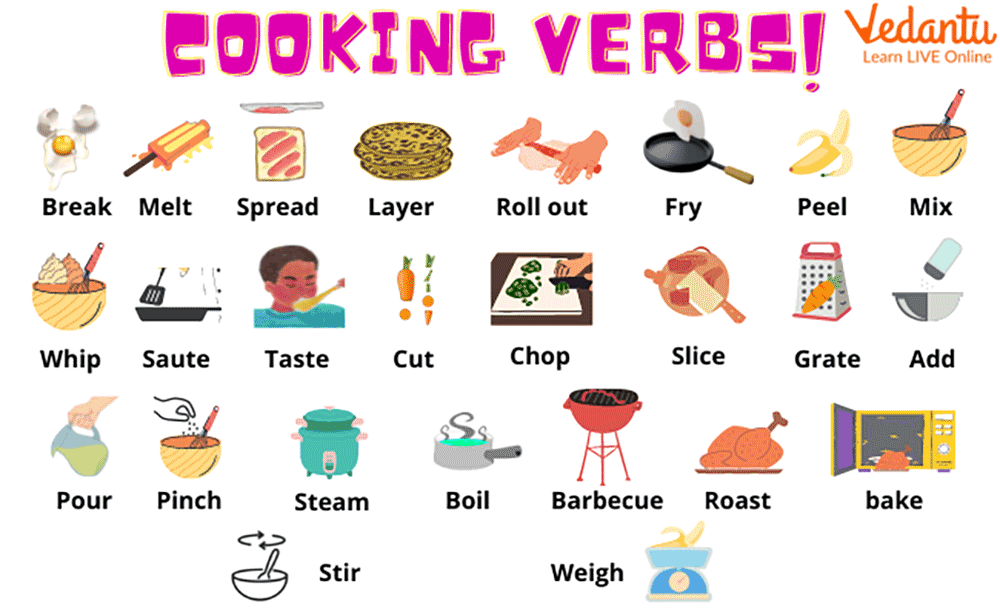




Top Cooking Verbs Every Kid Should Know in the Kitchen
Cooking is a fun family activity that also helps children learn new words by allowing them to practise cooking verbs and kitchen vocabulary.
If you spend a lot of time in the kitchen, whether for fun or for work, having a thorough understanding of cooking verbs will come in handy when speaking with other people in the kitchen. Cooking is something that we all need to do, and having the correct language for the job can make it a lot easier when you're working with people who speak English.
Overview of Cooking and the Benefits of Learning Cooking Verbs
Cooking with children provides significant advantages, like bringing families closer together and boosting children's self-esteem, not to mention the fact that cooking encourages children to try new healthy foods. Learning the cooking verbs is a great way to start having fun with the kids in the kitchen!
Children prefer being taught using a variety of teaching methods; they enjoy learning by touching, feeling, smelling, listening, and tasting since they are naturally curious. Cooking is a great approach to help young children learn because they can experience many things firsthand by actively participating in an activity like preparing their favourite food.
To make the cooking experience more enjoyable for the children, it is recommended that they acquire at least part of the cooking verbs and vocabulary. This way, they will be able to follow directions in the kitchen while learning new verbs or words. Teaching young children kitchen vocabulary may be a fun hobby with the aid of parents and family.
Cooking vocabulary and food terminology may be found here to help them increase their knowledge and make cooking a fun learning experience for the whole family.
Cooking Words or Verbs
From cooking tools to various measuring devices, the kitchen vocabulary is broad.
Cooking verbs, often known as kitchen verbs, are verbs that regularly appear in the cooking instructions of recipes. To improve your kitchen vocabulary, learn these important cooking terms.
Cooking Terms List
Break
Melt
Spread
Layer
Roll out
Fry
Peel
Mix
Whip
Saute
Taste
Cut
Chop
Slice
Grate
Boil
Steam
Pinch
Pour
Add
Barbecue
Roast
Bake
Stir
Weigh
And that's just the cooking terminology! Many other verbs related to preparation (slice, dice, bread, chop, mince, and drain) or plating (place, layer, scoop, and assemble) are available.
Conclusion
These many action words are all beneficial verbs to teach children because this will help them develop their vocabulary as well as teach them ideas like instruction writing and imperative language.
As a result, this practical theme is applicable not just to cooking classes or Health and Physical Education classes but also to English language acquisition.
Challenge your students to use each of these words in a sentence as a fun task before you start getting practical with recipes. Alternatively, write your own amazing recipes together and see how many different cooking verbs you can come up with.

The most common Cooking Verbs
FAQs on Essential Cooking Verbs for Kids: Master Kitchen Action Words
1. Give some of the common ways of cooking food.
A few of the most common ways of cooking food include the following:
Grill / Cook / Barbecue / Broil
Stir-Fry / Gratin / Roast / Bake / Stew
Steam / Caramelise / Toast / Saute / Poach
Simmer / Microwave / Glaze / Scramble
2. List a few verbs that are used while cooking.
There are many verbs that are used to describe the process of cooking food. A few of them include the following:
Slice / Add / Dice / Drain
Mix / Pour / Break / Beat / Grease
Combine / Carve / Chop / Knead
Stir / Measure / Peel / Mince / Dissolve
Pour / Crush / Weight / Whisk





















